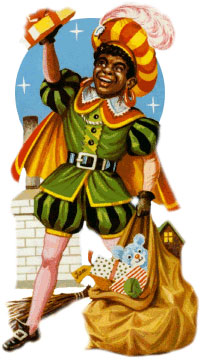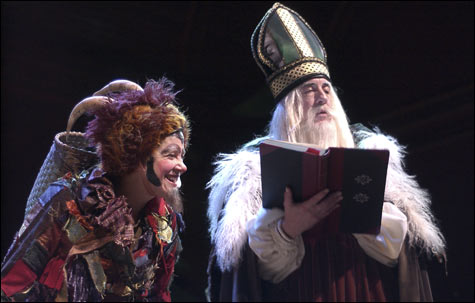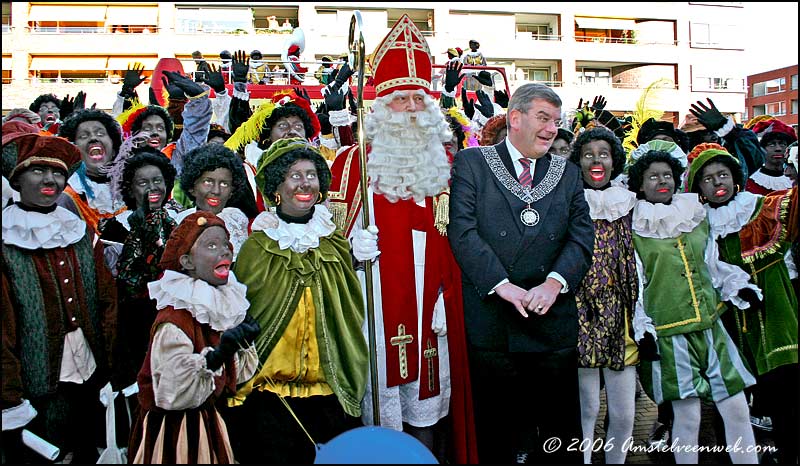Warning! This post reflects the culture found in the Netherlands and may therefore be a bit shocking to the "politically correct" culture found in the US! That's just how it is here folks!!
§§§§§§§§§§§§§§§§§§§§§§§§§§§§§§§§§§§§§§§§§§§§§§§§§§§§§§§§§§§§§§
 While I have given you the background on SinterKlaas, whose persona is not unfamiliar to American culture, and yes, ostensibly he is the "star" of the show, the show itself and all the build-up to Sint's arrival is done by the Zwarte Pieten (Black Peters). In the Netherlands, Belgium and Luxembourg, Zwarte Piet is Sint's helper or companion. We don't have elves here! The history behind this is that he was a servant or squire who helped Bishop Nicholas on his travels. The early legend is that he was a young, black slave named Peter that Nicholas had rescued and freed. He chose to stay with Nicholas rather than go out on his own. Other versions have it that he was a young page who got a black face because he was the one to climb down the chimneys and so he got covered in soot!
While I have given you the background on SinterKlaas, whose persona is not unfamiliar to American culture, and yes, ostensibly he is the "star" of the show, the show itself and all the build-up to Sint's arrival is done by the Zwarte Pieten (Black Peters). In the Netherlands, Belgium and Luxembourg, Zwarte Piet is Sint's helper or companion. We don't have elves here! The history behind this is that he was a servant or squire who helped Bishop Nicholas on his travels. The early legend is that he was a young, black slave named Peter that Nicholas had rescued and freed. He chose to stay with Nicholas rather than go out on his own. Other versions have it that he was a young page who got a black face because he was the one to climb down the chimneys and so he got covered in soot! In other cultures, the figure of Nicholas has different helpers. In many parts of Germany, this is a dark figure called "Knecht Ruprecht" which translates as Servant or Farmhand Ruprecht. In some instances the Saint and the Knecht play "good & bad" roles with Nickolas handing out treats while Ruprecht threatens to beat the children with switches if they don't behave! My DH grew up with the tradition that on 6.December, along with a small present from Sankt Nickolas, the children received a bundle of switches that are tied together with ribbon and hung with various chocolates and candies. Children were often admonished that if they did not behave, then all they would get is the bundle of switches! In the US you can hear this reflected in some of the tales about Santa Claus.
In other cultures, the figure of Nicholas has different helpers. In many parts of Germany, this is a dark figure called "Knecht Ruprecht" which translates as Servant or Farmhand Ruprecht. In some instances the Saint and the Knecht play "good & bad" roles with Nickolas handing out treats while Ruprecht threatens to beat the children with switches if they don't behave! My DH grew up with the tradition that on 6.December, along with a small present from Sankt Nickolas, the children received a bundle of switches that are tied together with ribbon and hung with various chocolates and candies. Children were often admonished that if they did not behave, then all they would get is the bundle of switches! In the US you can hear this reflected in some of the tales about Santa Claus. In other European countries, this helper has a similar role but different names: Krampus (in Austria, Hungary, Solvenia, Croatia and some surrounding reagions), Klaubauf (in southern Germany), Pelzebock, Pelznickel, Belzeniggl, Buzebergt, Rumpelklas, Bellzebub, Hans Muff, Hanstrapp or Drapp (in various regions of Germany, Austria, Switzerland, northern Italy, eastern France and countries bordering Germany), and Le Pere Fouettard
In other European countries, this helper has a similar role but different names: Krampus (in Austria, Hungary, Solvenia, Croatia and some surrounding reagions), Klaubauf (in southern Germany), Pelzebock, Pelznickel, Belzeniggl, Buzebergt, Rumpelklas, Bellzebub, Hans Muff, Hanstrapp or Drapp (in various regions of Germany, Austria, Switzerland, northern Italy, eastern France and countries bordering Germany), and Le Pere Fouettard  (Northern France). In most instances these companions are portrayed as ugly or comical figures, some even having horns and resembling a demon or devil. They often carry a rod or staff, sometimes a scythe or sword, or a whip or bundle of switches. And they all carry the sack for Saint Nicholas. In some incarnations, the companion is dressed in rags or all in black, while in others he is dressed like Nicholas, but has a darker complexion and dark hair and is unkempt compared to Nicholas. In some regions, however, Nicholas is accompanied by a young angel, a blond sweet-looking child or young woman. In the Czech Republic this is Anděl (Angel).
(Northern France). In most instances these companions are portrayed as ugly or comical figures, some even having horns and resembling a demon or devil. They often carry a rod or staff, sometimes a scythe or sword, or a whip or bundle of switches. And they all carry the sack for Saint Nicholas. In some incarnations, the companion is dressed in rags or all in black, while in others he is dressed like Nicholas, but has a darker complexion and dark hair and is unkempt compared to Nicholas. In some regions, however, Nicholas is accompanied by a young angel, a blond sweet-looking child or young woman. In the Czech Republic this is Anděl (Angel).Depending on the region, "Nicholas Day" is celebrated on the 5th or the 6th. In some areas, he arrives at the door and the children are summoned to perform a poem or song before they are given their presents. It may be that the companion reads a list of the things naught children have done or is angry and mean and telling the children they deserve no presents. But while this can be scary, it is also fun for many children and they look forward to the show every year, practicing what they will say to convince the visitors that they deserve a present (which they always get in the end!).
 But the Belgium-Netherlands-Luxembourg (Benelux) region is unique in its tradition of Zwarte Piet and this character is cherished as the biggest part of the Nicholas celebration. Through the years, especially since WWII, the legend developed to include more than one companion. Thus we have "Zwarte Pieten" (plural). All of them are named "Piet", and wear a colorful costume reminiscent of a Renaissance European page including pantaloons, ruffled collar, feathered cap, long stockings, buckled shoes (although nowadays replaced by sport shoes) and black gloves. But each has a different function and role to play in the ever-expanding drama that is the feast of SinterKlaas. Of course you have the main helper Piet (HoofdPiet), but also one in charge of the presents (PakjesPiet), one in charge of the poems (GedichtePiet), Piets in charge of Sint's horse Amerigo (PaardePieten), and of course dancing Piets, singing Piets, the Piets in charge of handing out/throwing the candy and cookies (StrooigoedPieten), etc. One of my favorite characters is MuziekPiet who is the lead singer and in charge of making up new songs for Sint. Funny, but instead of the usual Piet costume, he has a hairstyle
But the Belgium-Netherlands-Luxembourg (Benelux) region is unique in its tradition of Zwarte Piet and this character is cherished as the biggest part of the Nicholas celebration. Through the years, especially since WWII, the legend developed to include more than one companion. Thus we have "Zwarte Pieten" (plural). All of them are named "Piet", and wear a colorful costume reminiscent of a Renaissance European page including pantaloons, ruffled collar, feathered cap, long stockings, buckled shoes (although nowadays replaced by sport shoes) and black gloves. But each has a different function and role to play in the ever-expanding drama that is the feast of SinterKlaas. Of course you have the main helper Piet (HoofdPiet), but also one in charge of the presents (PakjesPiet), one in charge of the poems (GedichtePiet), Piets in charge of Sint's horse Amerigo (PaardePieten), and of course dancing Piets, singing Piets, the Piets in charge of handing out/throwing the candy and cookies (StrooigoedPieten), etc. One of my favorite characters is MuziekPiet who is the lead singer and in charge of making up new songs for Sint. Funny, but instead of the usual Piet costume, he has a hairstyle  and outfit resembling Elvis in his Las Vegas years!
and outfit resembling Elvis in his Las Vegas years! But all of the Zwarte Piets are black! No, not African-American! No these are black-faced characters and even those actors of darker complexion wear the black make-up! While there has been some controversy over the usage of blackface, and every year you can find discussion forums on the political correctness of this character, all efforts to change this have not been accepted. In 2006, one of the main TV stations in the Netherlands tried to introduce rainbow-colored Piets in an effort to get away from this stereotype. Viewers stayed away in droves and a parade hosted by the TV station with all different colored characters was booed by the public. The whole idea was dropped very quickly.
 Whereas in the US you may have someone dressed as Santa Claus collecting on a street corner, or even a street band of Santa Claus musicians, in the Benelux this is a role for Zwarte Piet. As Sint can't be everywhere at once, oftentimes you will only see Piets who then will collect the drawings and lists and be sure and bring them to Sint. One year DD1 was not at all impressed with the SinterKlaas we had met on the market. She informed me very knowingly that he was not the "real Sint", but just a helper dressed up like Sint as she was aware that SinterKlaas could not be everywhere at once. But, she informed me, the Piets were real. Thus she was not at all concerned that her drawing would not make it to the real SinterKlaas.
Whereas in the US you may have someone dressed as Santa Claus collecting on a street corner, or even a street band of Santa Claus musicians, in the Benelux this is a role for Zwarte Piet. As Sint can't be everywhere at once, oftentimes you will only see Piets who then will collect the drawings and lists and be sure and bring them to Sint. One year DD1 was not at all impressed with the SinterKlaas we had met on the market. She informed me very knowingly that he was not the "real Sint", but just a helper dressed up like Sint as she was aware that SinterKlaas could not be everywhere at once. But, she informed me, the Piets were real. Thus she was not at all concerned that her drawing would not make it to the real SinterKlaas.  Many schools have a day when Piets comes to visit and collect the drawings and wishlists from the children, leaving behind treats and small presents. Funny enough, though, these Piets often get a bit rowdy playing with the children's things and leaving behind a big mess at school. My daughters were outraged at these RommelPieten (messy Piets)!. And of course before the children were allowed to eat their treats they had to clean up the mess! At many schools every year there is some sort of theme around SinterKlaas and company. One year, one of the Piets had fallen in love with one of the teachers. Everyday the school received a love note with a clue as to which teacher it was. There were internal polls taken amongst the children as to who they thought it was. One class even made a bar graph showing the results. The speculation grew every day. One of the younger classes was very upset as they were sure it was their teacher and were afraid that she would go back to Spain with Piet and they did not want her to leave. They wrote a special letter to Sint and were relieved to learn with a personal letter from him that is was not their beloved teacher.
Many schools have a day when Piets comes to visit and collect the drawings and wishlists from the children, leaving behind treats and small presents. Funny enough, though, these Piets often get a bit rowdy playing with the children's things and leaving behind a big mess at school. My daughters were outraged at these RommelPieten (messy Piets)!. And of course before the children were allowed to eat their treats they had to clean up the mess! At many schools every year there is some sort of theme around SinterKlaas and company. One year, one of the Piets had fallen in love with one of the teachers. Everyday the school received a love note with a clue as to which teacher it was. There were internal polls taken amongst the children as to who they thought it was. One class even made a bar graph showing the results. The speculation grew every day. One of the younger classes was very upset as they were sure it was their teacher and were afraid that she would go back to Spain with Piet and they did not want her to leave. They wrote a special letter to Sint and were relieved to learn with a personal letter from him that is was not their beloved teacher. Dutch television has a special program each year with news about SinterKlaas and reports about all the various activities and dramas around his visit to the Netherlands. My daughters still insist on watching this every evening, though they really have outgrown SinterKlaas now. My blogfriend in Belgium, Goofball, reports that they have a different story there with Sint arriving in their country at a different location.
Now you have to understand the characters of ZwartePieten. Many of them are young and rather naughty. This stems from the original legend where they were naughty children who were put in Sint's sack and taken back to Spain! And they are very acrobatic (for the most part) as they are the ones who climb down the chimney and carry the sack of toys and treats. So of course almost every school gym lesson in November at some point has an obstacle course for the children to follow in order to earn the PietenDiploma!
 In the street parades and at the markets you will see a number of Piets handing out candy and pepernoten. But in some places they actually throw the candy, hence the term "Strooigoed" (stuff you throw). Especially at the school visits where the children perform for SinterKlaas, the Piets can be quite rambunctious and at times Sint has to calm them down. But it is all in good fun and the kids are usually quite happy to let the Piets join in their dances and throw candy at them. And whenever they see one on the street, the call to him by name yelling "Piet! Piet!" and are guaranteed a smile and a wave as if they are personally recognized. I have heard funny tales of Dutch children on summer vacation in Spain who, upon seeing a black person on the beach or street, have called out "Piet! Piet!". And in areas familiar with Dutch vacationeers, the child was usually rewarded with the same big smile and wave, thus confirming their identity!
In the street parades and at the markets you will see a number of Piets handing out candy and pepernoten. But in some places they actually throw the candy, hence the term "Strooigoed" (stuff you throw). Especially at the school visits where the children perform for SinterKlaas, the Piets can be quite rambunctious and at times Sint has to calm them down. But it is all in good fun and the kids are usually quite happy to let the Piets join in their dances and throw candy at them. And whenever they see one on the street, the call to him by name yelling "Piet! Piet!" and are guaranteed a smile and a wave as if they are personally recognized. I have heard funny tales of Dutch children on summer vacation in Spain who, upon seeing a black person on the beach or street, have called out "Piet! Piet!". And in areas familiar with Dutch vacationeers, the child was usually rewarded with the same big smile and wave, thus confirming their identity!  And while in the US you find Santa hats and outfits, for the most part in the Netherlands the children all want to dress up as Piet. Well of course! You get a really colorful costume, and you can choose whatever color you want. Oftentimes it is satin or some soft material, though the fancier ones include velvet. The ruffled collar is not always pleasant, but simpler costumes leave that out. And you get a great cap with a feather. Many schools have craft activities where the kids make their own feather cap. But best of all you get to put on black makeup! Some kids are content to just a few smudges on their cheeks, but others go all out with their entire face and neck covered in black. Topped off with a curly
And while in the US you find Santa hats and outfits, for the most part in the Netherlands the children all want to dress up as Piet. Well of course! You get a really colorful costume, and you can choose whatever color you want. Oftentimes it is satin or some soft material, though the fancier ones include velvet. The ruffled collar is not always pleasant, but simpler costumes leave that out. And you get a great cap with a feather. Many schools have craft activities where the kids make their own feather cap. But best of all you get to put on black makeup! Some kids are content to just a few smudges on their cheeks, but others go all out with their entire face and neck covered in black. Topped off with a curly  black wig and a cap, the sight of the white eyes and bright smiles (sometimes with missing teeth!) from such shiny black faces is comical and touching at the same time. And of course there are one or two who will dress up at Sint. But you get to have a lot more fun as Piet! No wonder the parents no longer threaten their children about getting put into the sack and sent off to Spain. Kids in the Netherlands love ZwartePiet and many would jump at the chance without hesitation! I know of several teenagers who relish their role every year as a "helper", spending money of their own to embellish their costumes.
black wig and a cap, the sight of the white eyes and bright smiles (sometimes with missing teeth!) from such shiny black faces is comical and touching at the same time. And of course there are one or two who will dress up at Sint. But you get to have a lot more fun as Piet! No wonder the parents no longer threaten their children about getting put into the sack and sent off to Spain. Kids in the Netherlands love ZwartePiet and many would jump at the chance without hesitation! I know of several teenagers who relish their role every year as a "helper", spending money of their own to embellish their costumes. So while he may be a bit outdated, and definitely on the naughty side with some of his antics, and he is certainly not politically correct and is definitely a stereotype, I can't help myself, I love ZwartePiet! I would definitely go off to Spain with him!!
§§§§§§§§§§§§§§§§§§§§§§§§§§§§§§§§§§§§§§§§§§§§§§§§§§§§§§§§§§§§§§§§§§§§§§§§§§§§§§§
So there you have the tradition as celebrated in the Netherlands, but I'm not done yet! Look for future blogs with this title to see how I combined the traditions of the Netherlands, Germany and the US into one story for my girls. And I will be posting a recipe (not something I often do) that includes what to do with all those extra pepernoten!!





14 comments:
This is fascinating. I can't wait for the next installment. Thanks for taking the time to share it all with us.
You are doing such a great job explaining this all.
And you are right...we'd never accept a "political correct" change to our Zwarte Pieten because we adore them just the way they are! While Sinterklaas is the static bishop, friendly and strict, ....it is the Pieten to whome we all can relate more with all their jokes, naughtiness, acrobatics, ...
I love Zwarte Piet too!!!!!!!!!!!
Ay yi yi...of course I'm admittedly troubled by the "black face" but it is somewhat interesting to read about other cultures holiday traditions
I am SO enjoying these posts. I have a fondness for finding out about holiday traditions around the world--and so much fun when they are holidays shared here in the U.S. and seeing how things differ, and how they relate.
Thanks for doing this, and keep it coming, I'll be looking forward to each installment.
Robin and Goofball,
Thanks for your support! It has been fun writing about the differences and getting a chance to explain them all!
Dear Worker Mommy,
I admit to having been disturbed and quite frankly shocked at the whole ZP image. But I came to realise that the blackface has nothing to do with any stereotypes. It is seen as just "dressing up" like putting on princess or dracula makeup! I finally overcame my discomfort when DD1 was in pre-school and a little boy from Kenya and his Dutch school-friend were fighting over who got to be ZwartePiet! They finally settled it with the Dutch boy playing ZP on the first day with the Kenyan boy dressing up as Sint! The next day they changed places, including makeup! (You see, Sint often has a white or pale pink made-up face with red cheeks!) It was so sweet, both days!!
Wholly Burble,
Don't worry, I still have a number of posts and stories to tell about this holiday!! Glad you are enjoying it!
I love, love, love the Pieten too! They are soooo much fun to see in the stores and at the parties and on the streets. Last night a band of them dropped by at the International School and boy, did they make a mess! So much trouble with the rommelpieten! Andrew was dumbstruck by all the mess. He was also incredibly pleased with all the candy which was left inside his shoe. And also a note from the Sint himself. What a great season this is for the kids.
In spite of it being "incorrect" I think it is a deep tradition here. I haven't met anyone personally who is deeply offended by it, and most seem content with the "new story" that the pieten must climb down a lot of chimneys so that's why their faces are black.
I do love them, every one, and will certainly run off to spain alongside you!
This is an amazing series, FA. It seems like you've been doing nothing but research! Thank you for all the enlightening, beautifully written posts!
This is awesome! I love the research and different language in all of these posts.
But I'm really looking forward to the piece about how you are combining all of these traditions.
BTW - finally did the meme you gave me earlier in the month.
Swarte Piet was on U.S. TV last night! Although they got the facts wrong - at least it wasn't in alignment with what you said. It was in the mystery series, Bones. We are Bones fanatics, I'm embarrassed to say.
I was curious about those characters in the photos you posted earlier. What a fun tradition! I'm loving these posts!
I've never heard of this tradition! I think I've held a Germanic stereotype of Northern European holiday. Another story, please...
6 more nights before December 6th
Ah, This is awesome! Dispells
a few misnomers I've heard
Post a Comment